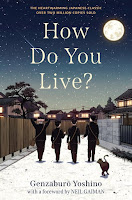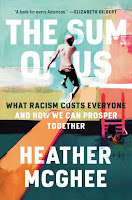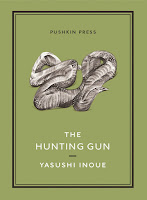Author: Genzaburo Yoshino (Author), Bruno Navasky (Translator)
Publication Information: Algonquin Young Readers. 1937 (original Japanese). 2021 (English translation). 288 pages.
ISBN: 1616209771 / 978-1616209773
Book Source: I received this book through NetGalley and a publisher's blog tour free of cost in exchange for an honest review.
Opening Sentence: "Copper is in his second year of junior high school."
Favorite Quote: "But even when you have read the books and learned the ideas, the ultimate key to the mystery will be - Copper, of course it will be you. You, yourself and no other. For it is only through the life you will lead, building on your many experiences and impressions, that you will be able to understand the truths in the words of these great thinkers."
***** BLOG TOUR *****
Review
I had never heard of this book or the author until seeing the marketing for the book. I am fan of Hayao Miyazaki's movies and of Neil Gaiman's work. Filmmaker Hayao Miyazaki calls this his favorite childhood book and is in fact basing a new Studio Gibli movie on this book. The book description also draws a comparison to The Alchemist by Paul Coelho, which I love.
This set up creates high expectations for the book. Although targeted to an audience aged 10-14, this book offers considerable philosophy to an adult reader. The title - how do you live - is very much literal. The book offers advice and principals for an ethical life.
The philosophy is embedded in the life of Copper, a young man whose nickname comes from the mathematician and scientist Copernicus. Copper is fifteen years old in this book and in junior high school - a challenging age in the best of circumstances. Copper's life is further challenged by the loss of his father.
Much of this philosophical advice resonates even as an adult reader. The book is at times sad and at times nostalgic. Given the time of its original publication, the book also captures the changing paradigm of life in the years leading up to World War II. As the translator's note points out, "... it contains many lessons, and a quiet but powerful message on the value of thinking for oneself and standing up for others during troubled times. In this respect, it's a unique book, and particularly valuable to us now..."
This story focuses on his life in school and with his friends and his relationship with his uncle - the father figure in his life. The chapters alternate with depictions of incidents in Copper's life and with writings of his uncle in a notebook destined to provide guidance to Copper in his life. The uncle's journal stems from his promise to Copper's father to help Copper become a "good" man.
The structure of alternating chapter does create a distance in the book from Copper's story, but perhaps that is intentional for it keeps the focus on principles being shared. Copper's story is a vehicle for the lessons in ethics rather than the lessons being a corollary to Copper's story.
The interesting aspect is that so many of the ideas share transcend time. So much of what is shared in this book published in the 1930s still holds true today. I suppose that is not surprising for the basic tenets of living a good and ethical life do not change. The lessons we learn in childhood and attempt to pass on to our own children remain constant ones of believing in yourself, standing up for what you believe in, and standing up for other even when they cannot.
The book is memorable, and in this case, I cannot wait to see the movie!
About the Book
First published in 1937, Genzaburo Yoshino’s enchanting novel HOW DO YOU LIVE? is finally available in English for the first time. Award-winning filmmaker Hayao Miyazaki (Spirited Away, Howl’s Moving Castle) has long referred to this coming-of-age classic beloved by millions of Japanese readers as not only a major influence on his work but also his favorite childhood book, and he has recently announced plans to base his final film on it. Brilliantly translated by Bruno Navasky and with a foreword by fantasy master Neil Gaiman, who wrote the English-language adaptation of Miyazaki’s Princess Mononoke, this new edition will introduce legions of new readers to Yoshino’s timeless tale.HOW DO YOU LIVE? begins with fifteen-year-old Copper, who has recently suffered the loss of his father, gazing out over his hometown of Tokyo, watching the thousands of people below, and beginning to ponder life’s big questions. How many people are in the world? What do their lives look like? Are humans really made of molecules? The book moves between Copper’s story and his uncle’s journal entries, in which he gives advice and helps Copper learn pivotal truths about the way the world works. Over the course of a year in his life, Copper, like his namesake Copernicus, embarks on a journey of philosophical enlightenment, and uses his discoveries about the heavens, earth and human nature to determine the best way to live. Yoshino perfectly captures the beauty and strangeness of pre-war Japan – the changing of the seasons, the fried tofu and taiyaki stands, and the lush landscapes, as Copper explores the city on his bike and learns from friends and family what really matters most in life. “It’s funny and sad in a particularly Japanese way. As I read more of the book, I discovered that it contains lessons on everything: art, science, language, history, politics and philosophy,” translator Bruno Navasky writes. “It also contains a quiet but powerful message on the value of thinking for oneself and standing up for others during troubled times.”
“Books like this are important,” writes Neil Gaiman in the book’s foreword. “I’m so glad Mr. Miyazaki is making his film because it means that eighty-four years after it was written, Yoshino’s novel can be read in English, in Bruno Navasky’s gentle and winning translation, and that I got to read it.” Perfect for fans of The Little Prince and the Alchemist, as well as Miyazaki fans eager to understand some of his most important influences, HOW DO YOU LIVE? is a whimsical and wise novel that will forever change the way readers think about their place in the world.
About the Author
Genzaburō Yoshino (1899-1981) was a Japanese writer and publisher. In 1935, he became director of a collection of educational books for young people. Yoshino stepped in to write How Do You Live? when Yūzō Yamamoto, the expected writer, fell ill. Since its debut as a novel and guide to philosophy for young people, How Do You Live? has been re-edited and republished more than eighty times, a reflection of the changing times and culture in Japan.About the Translator
Bruno Navasky is a teacher and writer, whose work as a translator and editor includes Festival in My Heart: Poems by Japanese Children and Poem in Your Pocket for Young Poets. He was the founding editor of American Poet, the journal of The Academy of American Poets, where he now serves on the board of directors. He lives and works in New York City.
Please share your thoughts and leave a comment. I would love to "talk" to you.





